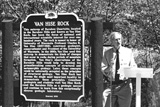Tucked away in the Baraboo River Valley gorge is the rock that made Wisconsin famous.
First used more than a century ago by University of Wisconsin geologist Charles R. Van Hise to teach some of the principles of geology, the solitary outcrop of Baraboo quartzite is for scientists the single most famous geological feature in the garden of stony wonders that is the Baraboo Hills.
A mecca of geology, like much of the region, the rock was used by Van Hise to show his disciples the hidden secrets of the structure and history of the Earth. And his students and generations of textbooks writers carried its lessons worldwide.

John Valley speaks at the dedication of Van Hise Rock.
The monolith nestled near the roadside on a curvy portion of State Highway 136 has long been a window to what the world was like more than a billion years ago. And now, the famous rock has gained historic merit. On May 9, 1999, Van Hise Rock became the 24th site in Wisconsin to be designated a national historic landmark, the highest honor bestowed by the National Park Service.
The educational value of the 1.7-billion-year-old rock, still visited by legions of students from all over the Midwest, lies in the story it tells about the geology of the Baraboo region and the insights it provides into the underlying processes that shape the Earth, according to Robert Dott, professor emeritus of geology.
The Baraboo Hills, says Dott, reflect a remarkable geologic history that encompasses almost half of the estimated four-billion-year age of the planet. Van Hise Rock, Dott explains, covers much of that history in one neat package.
The rock reveals features of a now-buried fold in the Earth's crust that tells a story of mountain building that occurred in the region an estimated 1.6 billion years ago. Van Hise, using the Baraboo Hills as a classroom, made Wisconsin internationally famous as a center of geological research and education.
The dedication of Van Hise Rock was on Sunday, May 9, at 1:30 p.m. in Abelman Gorge, one mile north of Rock Springs on Highway 136.